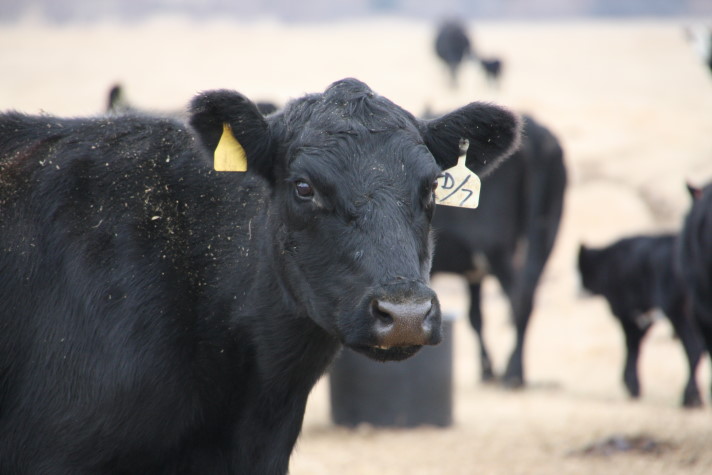
Agricultural News
Rebuilding the Beef Cow Herd Will Not be Easy- So Says Dr. Derrell Peel
Mon, 20 Dec 2010 16:53:39 CST
 Oklahoma State University Extension Livestock Market Economist Dr. Derrell Peel offers the following thoughts from his regular weekly look at the cattle markets via the electronic newsletter- Cow- Calf Corner:
Oklahoma State University Extension Livestock Market Economist Dr. Derrell Peel offers the following thoughts from his regular weekly look at the cattle markets via the electronic newsletter- Cow- Calf Corner:
With feeder cattle prices near record levels at the end of 2010, market incentives to rebuild critically low U.S. cattle numbers are increasing. Severe market shocks since late 2006 have completely masked the cattle cycle and the resulting additional liquidation has pushed the cow herd inventory to new lows. Though the annual cattle inventory report is a few weeks away yet, it appears the 2011 will begin with a beef cow herd that is close to two million head lower than the 2006 level, when the last expansion was interrupted. Although herd rebuilding is likely to occur in the coming months and years, several factors have changed that will impact how and where herd rebuilding will occur and, most importantly, how fast it will occur.
The biggest keys to heifer retention are the economic signals embodied in calf prices and producer expectations for the coming years. Although calf prices are near record levels, it is not clear that profitability is high enough to ensure herd rebuilding. In order to decide to retain a heifer, producer expectations have to be such that anticipated prices are high enough for long enough to make the present value for breeding exceed the current value of the heifer as a feeder animal. Many producers face high and volatile input costs that offset some of the incentive of higher cattle prices. Some of these impacts are regional, suggesting that rebuilding may be slower in some areas than others. For example, higher shipping costs have increased the discount on cattle in the Southeast, relative to the rest of the country. This fundamentally reduces the relative competitiveness of cattle in that region.
Broader changes in agricultural land use also increase the difficulty of rebuilding the beef cow herd in many regions. Increased demand for crop production means that improved pasture areas compete directly with crops for land use and indirectly for the inputs needed for crop or forage production. Increased crop production has led to loss of pasture and hay production in areas like Iowa and Missouri, and corresponding decreases in beef herd size. In other cases, high fertilizer and other input costs have led to reduced stocking rates that limit carrying capacity. In general, regions from the eastern Great Plains eastward are most affected by direct and indirect competition from crop production. In other regions, cow numbers have not decreased much or in some cases have increased already in response to these regional factors. Beef cow numbers in Montana, New Mexico and Oklahoma, for example were higher in 2010 than in 2006, when expansion was interrupted. Broadly speaking, beef herd expansion incentives will be higher in the western Great Plains and Rocky Mountain regions compared to the Midwest and Southeast. In other regions, other land use factors limit forage availability for cattle, including nonagricultural development and urban sprawl, and wildlife use.
Another unique feature of the current situation is the competing demands for both cow-calf and stocker production leading to increased demand for forage. Historically, cyclically high cattle prices resulted in incentives to emphasize cow-calf production and simultaneously deemphasize stocker production for a period of time. It worked well when grain was cheap. Today however, in addition to the need to increase cattle numbers, there is an ongoing need to reemphasize forage based production of feeder animals in response to permanently higher grain prices. The competitiveness of the beef industry in the future depends on capitalizing on the ruminant production flexibility that allows the industry to substitute forage for grains to some extent. Thus, the need to increase cattle numbers and emphasize stocker production both result in increased forage demand at precisely the time when increased competition with crop production is reducing forage supply, especially in some regions.
A final factor that is often mentioned to me is the demographics of cattle producers. The average age of cattle producers continues to increase and, for many older producers, there may be little interest in expanding cattle numbers regardless of incentives. The challenge of rebuilding the cow herd may be simultaneously a challenge of attracting younger producers into the industry who are willing and able to tackle the challenges and pursue the opportunities of a cattle industry that will be quite different in the future compared to the last few decades.
I am confident the market will provide the necessary incentives to rebuild the beef cow herd to meet market needs. However, I am not sure the current price levels are yet sufficient to ensure herd rebuilding. I suspect higher prices will yet be needed to provide the profitability and expectations necessary to retain enough heifers in enough regions to rebuild cattle numbers. Cow-calf producers need to strategically consider opportunities and challenges of herd expansion at several levels, including the overall industry situation and their specific geographic location, as well as their individual needs, resources, and plans.
WebReadyTM Powered by WireReady® NSI
Top Agricultural News
More Headlines...




















